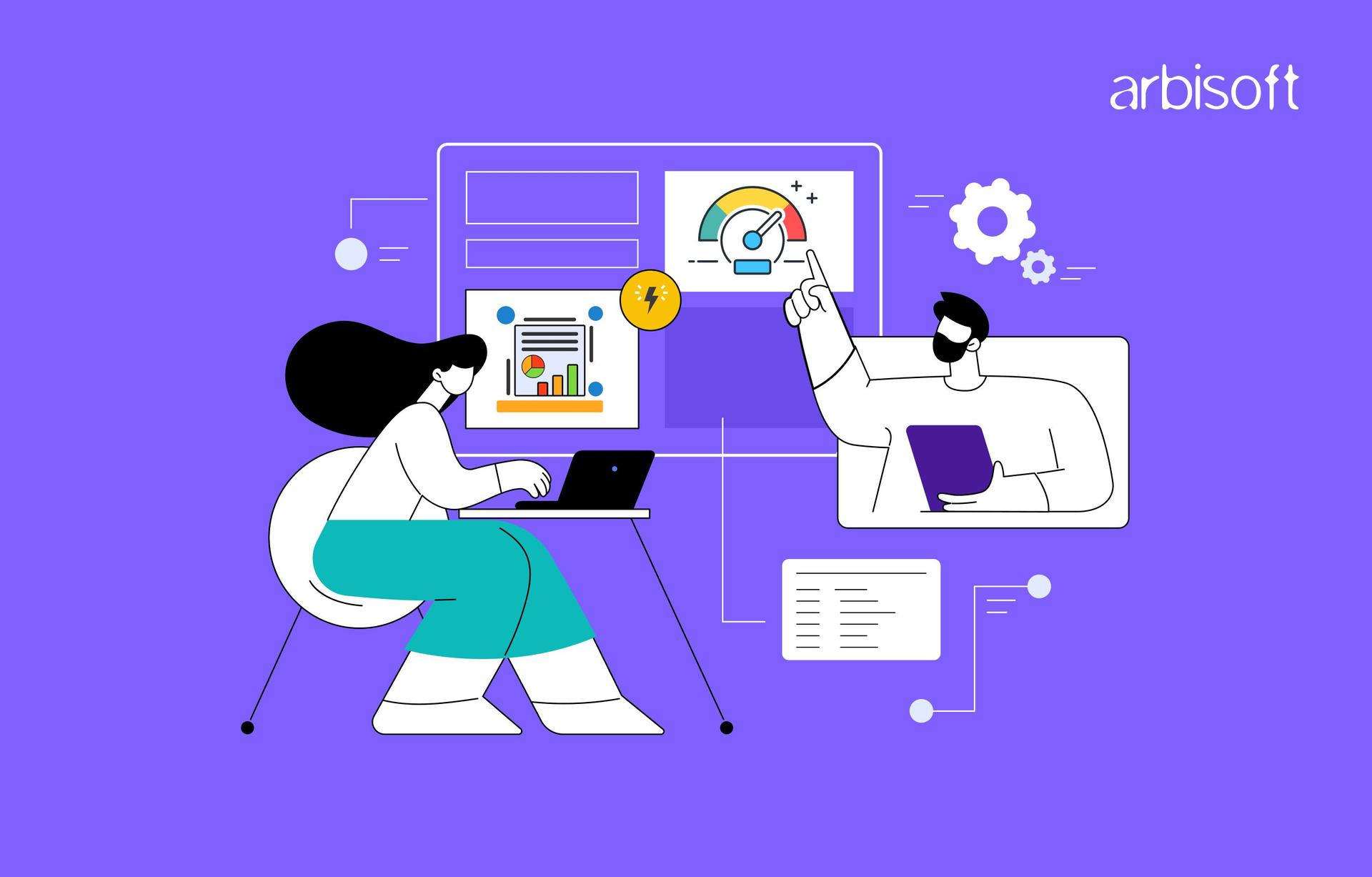We put excellence, value and quality above all - and it shows




A Technology Partnership That Goes Beyond Code

“Arbisoft has been my most trusted technology partner for now over 15 years. Arbisoft has very unique methods of recruiting and training, and the results demonstrate that. They have great teams, great positive attitudes and great communication.”
Performance Testing vs. Load Testing vs. Stress Testing - Which One Does Your Application Need?

In a world where downtime equals lost revenue, how confident are you in your app's performance under pressure?
Over 40% of users abandon a website after experiencing just one delay. Today the biggest competition is attention! To deliver a well-rounded user experience, it is critical to make sure that your app or website performs efficiently under all conditions. Yet, sometimes it is confusing to distinguish between performance testing, load testing, and stress testing. These three distinct methods help to achieve a great user experience.
This blog will clarify differences and guide you in selecting the right testing approach for your application.
The Basics – What Are They?
Performance Testing
Performance testing evaluates how well your application behaves under normal conditions. It focuses on speed, responsiveness, and stability. The goal is to identify bottlenecks quickly and ensure consistent performance. Performance testing also confirms that the app meets predefined benchmarks.
Key testing metrics for performance testing include:
- Response time
- Throughput
- Resource utilization
So if you are making a banking app then performance testing ensures that account balances load within two seconds during typical usage hours. This test will make sure that the customers don’t face delays in basic interactions.
Load Testing
Load testing simulates the expected user load on your application. By doing this it determines how the app handles typical and peak usage scenarios. It identifies the maximum operating capacity and reveals system bottlenecks before they impact real users.
Key testing metrics for performance testing include:
- Scalability
- System capacity
- Error rates under load
This test can be best applied on sites or apps with huge traffic flux - like online learning platforms. They are likely to expect increased traffic during peak enrollment periods. Load testing ensures that thousands of students can register simultaneously without slowdowns or system crashes.
Stress Testing
Stress testing goes beyond normal operational limits to evaluate how the system behaves under extreme conditions. It identifies breaking points and assesses the application’s ability to recover from failures.
Key testing metrics for performance testing include:
- Failure thresholds
- Recovery time
- System resilience
A gaming platform launching a new title might experience an unexpected influx of players. Stress testing ensures the platform can handle double the predicted traffic and recover quickly if servers become overloaded.
Are you confused and uncertain about what you hear about the testing processes and want to debunk it?

Debunk the top 8 myths about the testing processes that might affect the performance of your application.

Choosing the Right Testing for Your Application
Choosing the right testing approach—performance, load, or stress—depends on several factors. It may include your application’s specific functionality, traffic expectations, and how critical uptime and responsiveness are to your business. Here's how to determine the best fit for your needs:
1. Start with Performance Testing
Performance testing is the basic! It should be part of every application’s development process. It ensures basic functionality and optimal user experience during normal usage. The best use can be for any application with defined performance benchmarks, such as response times or resource usage.
Popular Tools - JMeter, NeoLoad.
2. Use Load Testing for High-Traffic Scenarios
Load testing is essential for applications anticipating significant traffic during specific periods. This testing can be beneficial for e-commerce platforms before sales events, video streaming apps during major releases, or education portals during exams.
Popular Tools - LoadRunner, Apache Benchmark.
3. Apply Stress Testing for Extreme Situations
Stress testing is critical for applications that must remain operational during unexpected surges or failures. Stress testing is popular in disaster recovery planning, infrastructure scaling, or preparing for viral campaigns.
Popular Tools - Locust, k6.
More Points to Consider
1. Understanding Application Needs
Every application has a different purpose, which determines its testing priorities. By understanding these unique needs, you can focus on the most relevant testing strategies for optimal results.
A few examples of specific needs
If your apps handle sensitive transactions - like the financial apps where speed and accuracy are critical then performance testing is critical. This testing ensures quick response times for operations like fund transfers and balances, reducing user frustration.
All the same, stress testing can help prepare for spikes during the tax cycle or payday traffic. This will ensure that no transaction is failed.
On the contrary, if there is a streaming platform, then it must handle high traffic during popular events like new movie releases or live concerts. Load testing ensures the app can manage concurrent users without buffering issues or downtime.
Similarly, shopping platforms experience traffic surges during seasonal sales or promotions. Load testing makes sure that the search, checkout, and payment functions keep working well. Stress testing checks to see if the site can handle being overloaded in situations like flash sales.
If you want to make QA more effective, try combining it with Exploratory Testing and proven qa testing services for comprehensive quality assurance.
2. Consider Business Impact
Testing isn’t just about the technical aspects - it directly affects your business outcomes. The right testing strategy can protect your revenue, reputation, and compliance standing.
- Downtime Costs
Downtime during high-demand periods can lead to significant financial losses and damage your reputation. For example, an online retailer’s website crash during Black Friday can result in millions in lost sales. Load testing helps prevent such incidents by identifying system weaknesses early.
- Customer Experience
Slow-loading apps or frequent crashes frustrate users and can drive them to competitors. Performance testing ensures the app meets user expectations for speed and reliability, directly impacting customer retention.
- Compliance Needs
Industries like healthcare and finance often have strict regulatory requirements for system performance and reliability. Stress testing ensures these apps can withstand emergencies or high-demand periods while maintaining compliance with industry standards.
3. Prioritize Based on Development Stage
The type of testing needed often depends on where the application is in its lifecycle. When testing methods are matched with development steps, resources are used more efficiently and results are better.
- Early Development
Performance testing is key at this stage. It helps identify and fix basic bottlenecks. Testing the app this way makes sure it works well before adding more features.
- Pre-Launch
Load testing becomes essential here. Stimulating expected user traffic can make sure that the app can handle high demand without crashing.
- Post-Launch
Stress testing prepares the application for unexpected surges. It also checks if the system can recover quickly to minimize downtime in extreme situations.
4. Testing with Goals
Your testing needs to evolve as your application grows. Your app will be able to handle more users if you start with simple speed testing and work your way up to more complicated methods like load and stress testing.
- For Startups
A small application with a limited user base might begin with performance testing services to make sure that it runs smoothly under normal conditions.
- As the User Base Grows
To get the app ready for more traffic, load testing is needed. It keeps the app from slowing down as it gets more traffic.
- For Businesses
Stress testing ensures large-scale applications can handle extreme events. These include global marketing campaigns or seasonal sales.
Best Practices for Effective Testing
To ensure your testing is both effective and efficient, here are some best practices to follow:
- Establish specific targets for response times, system capacity, and failure recovery. For example, aim for a response time under 2 seconds during peak usage.
- Use data and traffic patterns that reflect actual user behavior. This helps ensure your app performs well under typical and extreme conditions. This will make the tests more reliable.
- Don’t just identify problems—use the insights to optimize your code, infrastructure, and database queries. Fixing issues at the root level leads to better long-term performance.
- Make testing part of your regular development cycle. Each update, new feature, or change in traffic demands fresh tests to avoid introducing new vulnerabilities or performance issues.
- After testing, continuously monitor the app’s performance in the real world. Set up automated alerts to detect any issues early, allowing quick fixes before they affect users.
If you want to explore more best practices in-depth then head on to our blog for Improving Mobile App Performance: Best Practices for Android Development
In The End
Understanding the differences between performance, load, and stress testing ensures your application meets user expectations. It will also scale efficiently and recover gracefully from failures. By integrating these testing methods into your development cycle and employing software development services when needed, you can deliver a product that stands up to real-world demands.
Ready to enhance your testing strategy? Start small with performance testing, scale up to load testing, and stress test for future growth. Your users—and your bottom line—will thank you.
























